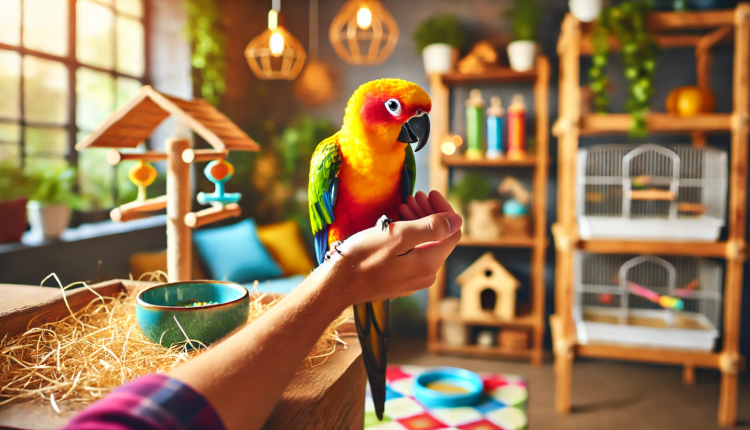The Intricacies of Parrot Socialization: Building a Trusting Relationship with Your Feathered Companion
Parrots are among the most intelligent and social creatures in the avian world. Their vibrant plumage and ability to mimic human speech have made them popular pets. However, their complex social needs require dedicated attention to ensure they lead fulfilling lives in captivity. This article delves into the nuances of parrot socialization and offers guidance on fostering a trusting and enriching relationship with your feathered friend.
Understanding Parrot Social Behavior
In the wild, parrots are inherently social animals, often living in large flocks that provide safety, social interaction, and learning opportunities. These flocks operate with intricate social hierarchies, and individual parrots form strong bonds with their mates and other flock members. This natural inclination towards socialization means that parrots in captivity crave interaction and mental stimulation to thrive.
Key Aspects of Parrot Social Behavior:
- Flock Dynamics: Parrots rely on their flock for protection, foraging, and learning survival skills. The flock’s social structure teaches them communication cues and acceptable behaviors.
- Pair Bonding: Many parrot species form monogamous pair bonds, engaging in mutual preening and synchronized activities, which are essential for their emotional well-being.
- Vocal Communication: Parrots use a range of vocalizations to convey information, signal danger, or maintain group cohesion. Mimicking sounds is also a way to integrate into their social environment.
The Importance of Socialization in Captivity
A well-socialized parrot is more likely to be confident, less stressed, and exhibit fewer behavioral problems. Socialization helps in:
- Reducing Fear: Regular positive interactions with humans and other pets can minimize fear responses.
- Preventing Behavioral Issues: Socialized parrots are less prone to issues like feather plucking, excessive screaming, or aggression, which often stem from boredom or isolation.
- Enhancing Mental Stimulation: Interaction provides mental challenges that keep parrots engaged and happy.
Steps to Socialize Your Parrot
- Start Early: If possible, begin socialization during the early stages of your parrot’s life. Young parrots are more adaptable and open to new experiences.
- Create a Safe Environment: Ensure your parrot’s space is secure and free from potential threats. A comfortable environment encourages exploration and interaction.
- Consistent Interaction: Spend quality time with your parrot daily. Talk, sing, or simply sit near them to build familiarity.
- Positive Reinforcement: Use treats and praise to reward desired behaviors. This encourages repetition of those actions.
- Introduce New Experiences Gradually: Slowly expose your parrot to new toys, sounds, and environments to build confidence without causing overwhelm.
- Encourage Gentle Handling: Teach your parrot to be comfortable with handling by gently touching and holding them, always respecting their comfort levels.
- Socialize with Other Birds: If feasible, allow your parrot to interact with other birds. This can provide valuable social learning opportunities.
Building Trust with Your Parrot
Trust is the foundation of any relationship with a parrot. Building trust requires patience, consistency, and understanding.
Strategies to Build Trust:
- Respect Their Space: Allow your parrot to acclimate to new surroundings and people at their own pace.
- Observe Body Language: Learn to read your parrot’s cues to understand their comfort levels and preferences.
- Avoid Forced Interactions: Never force your parrot into situations that cause stress or fear, as this can damage trust.
- Offer Choices: Giving your parrot control over certain aspects of their life, like choosing toys or perches, can empower them and build confidence.
Common Challenges in Parrot Socialization
Socializing a parrot can come with challenges, especially if they have had negative experiences in the past.
Common Challenges:
- Fearfulness: Some parrots may be naturally timid or have had traumatic experiences that make them wary of humans.
- Aggression: Lack of socialization or mishandling can lead to aggressive behaviors.
- Environmental Stressors: Loud noises, other pets, or frequent changes can cause stress, hindering socialization efforts.
Overcoming Challenges:
- Patience and Consistency: Build trust slowly, celebrating small victories along the way.
- Professional Guidance: Consult avian behaviorists or veterinarians for tailored advice.
- Environmental Enrichment: Provide toys, puzzles, and perches to keep your parrot mentally stimulated and reduce stress.
The Role of Environmental Enrichment
Environmental enrichment is crucial for a parrot’s mental and physical health. It involves providing stimuli that encourage natural behaviors and prevent boredom.
Types of Enrichment:
- Foraging Opportunities: Hide food in toys or around their enclosure to encourage natural foraging behaviors.
- Physical Exercise: Provide space and accessories for climbing, flying, and playing to promote physical health.
- Sensory Stimulation: Introduce new sounds, sights, and textures to engage your parrot’s senses.
- Social Interaction: Engage in regular play and training sessions to strengthen your bond.
Conclusion
Socializing your parrot is a continuous journey that enriches both your life and theirs. By understanding their natural behaviors, providing consistent and positive interactions, and creating an enriching environment, you can build a trusting and fulfilling relationship with your feathered companion. Remember, patience and empathy are key, as each parrot is unique and will socialize at their own pace.

